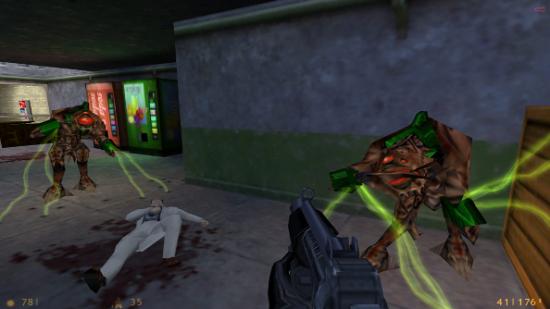Half-Life will always be remembered as one of the classics, but even it had its fair share of well-documented development issues. Just six months before the game’s release a new writer, Marc Laidlaw, came onto the project. He thought he’d be just helping polish the game up, but he ended up tearing it wide open to edit and rewrite the entire thing.
For more blasts from the past, check out our list of the best old games.
At this point, Half-Life felt like a connection of different ideas, all linked together tenuously. “There was an experimental portal device, several silos, some train tunnels, a nuclear reactor, and endless miles of corridors and air ducts,” Laidlaw explains in a blog post.
“They were great sets, but it was not at all clear what kind of continuing drama could ever unfold against them. Half-Life was still an anthology, when what Valve really wanted to create was something with the coherence and unity of a novel.”
As a former novelist, he hoped he could do what every writer does when they reach the end of a book: go through again and refine it. But that wasn’t to be, and instead they jammed a crowbar into the game’s inner workings, ripping and tearing bits out that didn’t fit, trying to make the entire thing cohesive.
“The floor of the office was strewn with Half-Life components,” he says. “We tore the game to pieces, trying to determine what worked, what might work someday, and what would probably never work given what we knew about our abilities. It was in some ways an extremely painful process – both because we knew that the game was going to slip far longer than anyone liked, and because it meant that a great deal of work was going to be lost and probably never seen again.”
This wasn’t Laidlaw throwing away pages of his own writing, though – he was tasked with ripping out the work of not only writers, but animators, artists, coders and all other games development disciplines, with months of work thrown in the recycle bin.
“The crucial milestone for me was the completion of our first rough mock-up of the entire game – in essence our first rough draft,” Laidlaw says of the rebuild. “I knew that once we could move through the maps from beginning to end, without cheating, we would all discover a new vision of the game. Something closer to the final vision. This was something I believed very strongly, based on my experience as a writer. First drafts exist only to teach you what you really want to accomplish.”
Other story writing techniques were also applied to the game, with later ideas revisited earlier on, like how a novelist might revisit an earlier chapter to sprinkle in some foreshadowing.
“One of the cleverer constructions in Xen, our alien dimension, is a series of puckered orifices which swallow you and spit you high into the sky for a lethal fall. These were picked up by one of the other designers and worked back into the terrestrial levels, giving the impression that the earthly plane is being infested by the alien one.
“Then a third designer did more benign earthly versions which fling you one or two stories high. So the puckers turned from a localised trap into an important gameplay element for a significant part of the game. This kind of borrowing and scattering of imagery is a function of revision, and to me one of the most effective things that happened spontaneously in the latter stages of Half-Life’s creation.”
Of course, Laidlaw wasn’t responsible for all of this, though he says he did his best to encourage it whenever he could. He also had to keep the vision of the story intact, just as the game’s shifting design killed of crucial story elements.
“Several times we had Valve-wide meetings where I would tell the entire story of the game as we understood it from beginning to end, so that everyone would be on the same page as we went forward. But invariably, as soon as those meetings were over, we’d find some reason to change the story yet again,” he explains. “As we drew closer to our deadlines, everyone became so busy with their parts of the Half-Life universe that they rarely had time to think about the big picture. Everyone assumed that someone else was keeping track of the grand scheme. I was the only person who wasn’t allowed to assume that.”
He goes on to explain some other ideas that ended up on the cutting-room floor, where Half-Life was originally planned to be non-linear. or how Valve nearly went for third-person cutscenes.
“I came into Valve with a deep prejudice against cinematics,” he says. “My feeling was that if we were going to do a first person game, we should stay in first person the entire time, and never break the narrative spell or jar the player out of the story for even a moment. Midway through the process, I became a reluctant advocate of the camera. Some of us were convinced that important scripted sequences would only work if we could lock the player into position.”
Read the entire thing over on Laidlaw’s blog.
